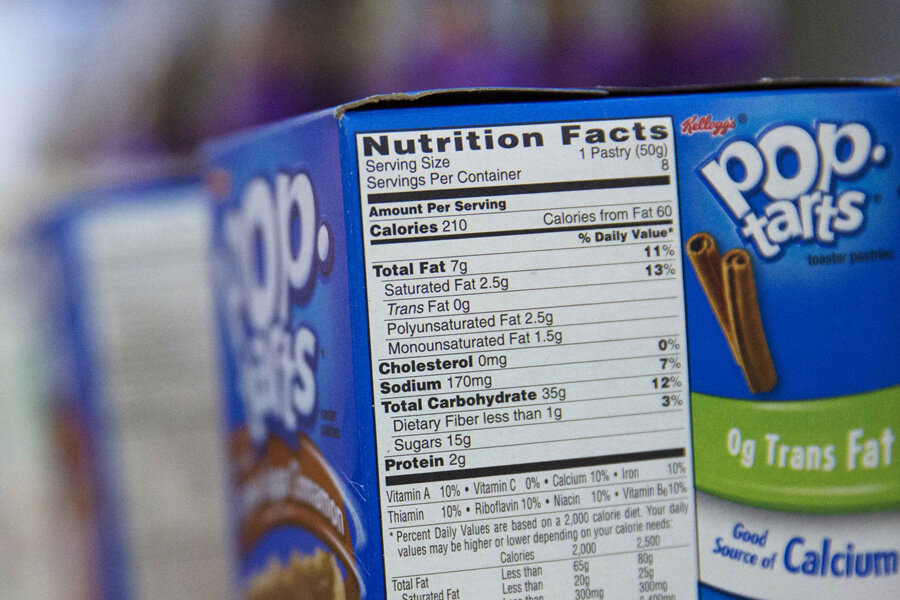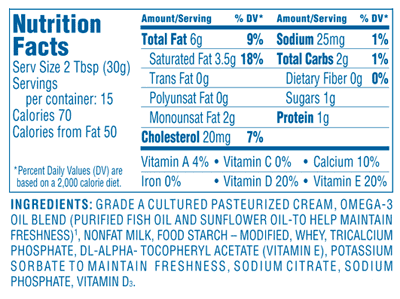45 food labels low fat
Food Labels: Fat & Cholesterol | Home & Garden Information Center Be aware that the word "low-fat" on the label doesn't automatically mean that a food is "low-calorie." "Low-fat" and "fat-free" foods, such as muffins and desserts, often contain more sugars and as many calories as the regular versions. You don't have to eat all low-calorie and low-fat foods. How to Read Food Labels Without Being Tricked - Healthline Yet, one brand's low-calorie version may have similar calories as another brand's original. Low-fat. This label usually means that the fat has been reduced at the cost of adding more sugar. Be very...
Understanding Food Nutrition Labels | American Heart Association Remember that the information shown in the label is based on a diet of 2,000 calories a day. You may need less or more than 2,000 calories depending upon your age, gender, activity level, and whether you're trying to lose, gain or maintain your weight. When the Nutrition Facts label says a food contains "0 g" of trans fat, but includes ...
Food labels low fat
Reading and Understanding Food Labels and Nutrition Info - Beaumont Health A one-percent reduction of saturated fat in your diet reduces your heart disease risk by three percent. Keep saturated fat to less then 15 grams per day. It is not required to list unsaturated fats (polyunsaturated and monounsaturated) on food labels. In general, unsaturated fats lower cholesterol. The healthiest unsaturated fat is canola oil. Low-Fat Foods - American Cancer Society Low-fat foods to choose from Dairy and dairy-like products Low-fat (1%) or fat-free (skim) yogurt, cottage cheese, or milk Neufchatel or "light" cream cheese or fat-free cream cheese Fat-free American cheese or other types of fat-free cheeses Fish, meat, poultry, and other protein Egg whites or egg substitutes Fats | Nutrition.gov Look up how much fat is in popular foods, like avocados and eggs. ... where it is found, and how you can use the Nutrition Facts Label for reducing saturated fat in your diet. The Skinny on Fat. HHS, National Institutes of Health. Fat is an essential nutrient for our bodies. ... Use this list of low-calorie, lower-fat alternatives to provide ...
Food labels low fat. Food Labels: How to Decode the 11 Trickiest Terms If more than half of a light product's calories are from fat, the fat should be reduced by at least half per RACC. If fewer than half its calories come from fat, the food can be called light if the... Reading Food Labels | ADA - American Diabetes Association Put food labels to work. The Nutrition Facts labels on foods are really the key to making the best choices. We'll cover the basics so that these labels make shopping easier for you. You've heard it all. From carb-free to low-carb, to whole and empty carbs, it's hard to know what it all means. Blood sugar highs and lows aren't always ... Food Labeling & Nutrition | FDA Food labeling is required for most prepared foods, such as breads, cereals, canned and frozen foods, snacks, desserts, drinks, etc. Nutrition labeling for raw produce (fruits and vegetables) and... Food Labels Explained - Farm Aid Organic labels can be found on produce, dairy, meat, processed foods, condiments and beverages. Food products labeled "organic" must contain at least 95% organic ingredients with no synthetic growth hormones, antibiotics, pesticides, biotechnology, synthetic ingredients or irradiation used in production or processing.
Food labels - NHS Some front-of-pack nutrition labels use red, amber and green colour coding. Colour-coded nutritional information tells you at a glance if the food has high, medium or low amounts of fat, saturated fat, sugars and salt: red means high amber means medium green means low In short, the more green on the label, the healthier the choice. Food Labels | CDC If you eat the whole thing, you are eating 8 times the amount of calories, carbs, fat, etc., shown on the label. Total Carbohydrate shows you types of carbs in the food, including sugar and fiber. Choose foods with more fiber, vitamins, and minerals. Choose foods with lower calories, saturated fat, sodium, and added sugars. Avoid trans fat. What does low fat, light mean on a food label? - Common Health Myths 13 Misleading Food Label Claims and How Not to Be Tricked The use of the term low-fat is governed by the FDA, which dictates that products must not contain more than 3 grams of fat per 50 grams. For meals and main dishes, foods are expected to contain no more than 3 grams of fat per 100 grams, and more than 30 percent of the calories cannot come from fat. 8. Label Says Made With Whole Grains
Reading Food Labels When You Have Diabetes - WebMD Reduced cholesterol. At least 25% less cholesterol and 2 g or less of saturated fat. Calorie free. Less than 5 calories. Low calorie. 40 calories or less. Light or lite. 1/3 fewer calories or 50% ... Understanding Food Terms - American Cancer Society Low. How you might see it on a label: low-fat, low-sodium, low-cholesterol, low-calorie What it means: This term can be used on foods that can be eaten often and you still won't get more than the recommended amount of that nutrient. The nutrients that can be described with this label are: Fat; Saturated fat; Cholesterol; Sodium (salt) Food Labels: What does the 'low fat' label actually mean? To get you up to speed, a product can only use the low-fat claim if it has less than 3g fat per 100g (and if it's a liquid, it has to have less than 1.5g fat per 100g). In essence, that means that just because something is labelled as low fat, it doesn't automatically make it healthy - it could be bursting with sugar or salt instead. Food Packaging Claims | American Heart Association "Very Low" and "Low" means the food has a little more than foods labeled "Free." "Reduced" or "Less" mean the food has 25% less of a specific nutrient than the regular product. "More," "Fortified," "Enriched," "Added," "Extra," or "Plus" means the food has 10% or more of the Daily Value (DV) than the regular product.
What the Labels Mean - Calorie Control Council LOW-FAT 3 grams or less of total fat for a given reference amount LOW-CALORIE no more than 40 calories for a given reference amount (except sugar substitutes) LOW-CHOLESTEROL 20 milligrams or less cholesterol and 2 grams or less of saturated fat for a given reference amount
Understanding Food Labels, Low Fat, Sugar and Salt Remember, food manufacturers use many different names for fat and sugars. Traffic light system: Some food labels use red, amber and green colour coding which makes it easier to choose food that is lower in total fat, saturated fat, and sugar and salt. Choose more 'greens', 'ambers' and fewer 'reds'.
How To Read Food and Beverage Labels - National Institute on Aging If a food has 5% DV or less of a nutrient per serving, it is considered low in that nutrient. If it has 20% DV or more of a nutrient per serving, it is considered high in that nutrient. Low or high can be either good or bad — it depends on whether you need more of a nutrient (like dietary fiber) or less (like saturated fat).
Nutrient Claims on Food Labels | Home & Garden Information Center At least 25% less sugar*. Fiber Claims. (If food is not low in total fat, the label must state total fat in conjunction with the fiber claims.) High fiber. 5 grams or more. Good source of fiber. 2.5 grams to 4.9 grams. More or added fiber. At least 2.5 grams more*.
PDF Food Label Tip: How to Choose Foods Low In Saturated Fat, Trans Fat ... Fat-free milk is a better choice. Potato Chips Microwave Popcorn These food labels are for one serving of potato chips (about 12 chips) and one serving of microwave popcorn (1 cup). Microwave popcorn has the lowest % of saturated fat and the lowest amount of trans fat. It has 5% saturated fat and 0 grams of trans fat.
Reading Food Labels (for Parents) - Nemours KidsHealth Trans fat should be as low as possible (less than 1% of total calories). Unsaturated Fat Unsaturated fats may also be listed under total fat. Unsaturated fats are often called "good fats" because they don't raise cholesterol levels as saturated fats do. Most fats should come from sources of unsaturated fats. Cholesterol
13 Low-Fat Foods That Are Good For Your Health Summary Fruits are sweet, low-fat foods loaded with antioxidants, which protect your cells against free radical damage. 3. Beans and Legumes. Legumes — also known as pulses — are a class of ...
Don't Be Fooled By These Food Labels - Health Two percent milk sounds great—it's such a low number! What most people don't realize is that whole milk contains only 3.25% fat. So 2% milk contain less fat than regular milk, but not that much. It...
How to Understand and Use the Nutrition Facts Label | FDA Nutrients to get less of: Saturated Fat, Sodium, and Added Sugars. Saturated fat, sodium, and added sugars are nutrients listed on the label that may be associated with adverse health effects - and...
Fats | Nutrition.gov Look up how much fat is in popular foods, like avocados and eggs. ... where it is found, and how you can use the Nutrition Facts Label for reducing saturated fat in your diet. The Skinny on Fat. HHS, National Institutes of Health. Fat is an essential nutrient for our bodies. ... Use this list of low-calorie, lower-fat alternatives to provide ...
Low-Fat Foods - American Cancer Society Low-fat foods to choose from Dairy and dairy-like products Low-fat (1%) or fat-free (skim) yogurt, cottage cheese, or milk Neufchatel or "light" cream cheese or fat-free cream cheese Fat-free American cheese or other types of fat-free cheeses Fish, meat, poultry, and other protein Egg whites or egg substitutes
Reading and Understanding Food Labels and Nutrition Info - Beaumont Health A one-percent reduction of saturated fat in your diet reduces your heart disease risk by three percent. Keep saturated fat to less then 15 grams per day. It is not required to list unsaturated fats (polyunsaturated and monounsaturated) on food labels. In general, unsaturated fats lower cholesterol. The healthiest unsaturated fat is canola oil.











Post a Comment for "45 food labels low fat"